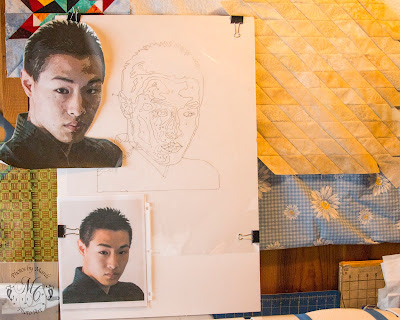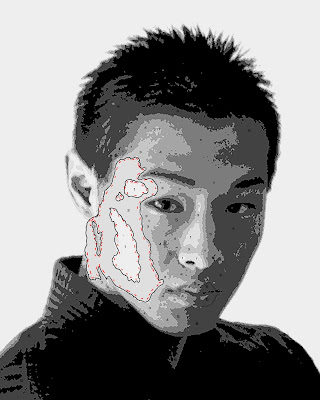I sit down to write about quilting, but must admit that I haven't sewed a stitch this week. We have had our first bout of nice weather and just had to get out in the yard. We emptied all the rocks out of our faux pond and cleaned them off. Next we will lay down landscape cloth and put the rocks back. It will be so nice to see the pond without weeds. We have occasional heavy rains here in the mountains so we designed the pond as a catch basin to slow the water down and reduce erosion. Normally it is fake with no water in it. While DH does the rocks, I dig dandelions.
As the yard improved the sewing room disintegrated. Now I have to go in and straighten things out to get ready to sew again, but I can carry on for blog purposes with the next steps of creating my thread painted portrait.
I now have three copies of the design (scroll down to last week's blog to catch up). The copy on mylar I leave on the foam core board, and set it up for viewing and checking as I progress. I am going to cut out fabric pieces along the lines drawn on the paper patterns. The beauty of this method is that you can see what the portrait looks like before you thread paint. If a color is wrong, you can replace it with a different fabric before it is too late.
Copy #2. The one that does not have the little red markings I place on my light table and cover it with a silicone pressing sheet. Tape the paper pattern to the back of the pressing sheet or secure both paper and pressing sheet to the light table. The point is to avoid slippage of either one while you work.
TIP: I use a plexiglass sewing machine extender table as my light box. The light is provided by an OTT light folded out flat.
TIP: Set out another pressing sheet on your regular ironing surface for use with fusing, and for ironing freezer paper patterns to the fabric. I even have a protective cover for my iron. All this is to reduce the amount of errant fusible gumming up my equipment.
 |
Protective cover on my iron. Pressing sheet on the ironing board (left).
I also keep a little Clover iron hot for tiny pieces. |
sub-TIP: Keep the ironing space separate from the cutting space if you can (I didn't). See below what happened to my extra pressing sheet. Next time I will tape it to the ironing board (at least at the front) so the scissors can't slip underneath and slice it while I nonchalantly cut my fabric.
 |
| Oops!! |
Copy #3 is going to be cut into pieces as patterns for cutting the fabric. I cut only one piece at a time, starting with the lightest value.
**Roughly cut a piece of fusible (I like Soft Fuse) a little bigger than your pattern piece and fuse it to the wrong side of your chosen fabric.
**Then on your protected ironing surface, lightly press the paper pattern shiny side down to the right side of the fabric. The fusible side sticks to the pressing cloth, but pulls right up leaving the fusible where it belongs - on the back of the fabric.
**Lift up the fabric and paper pattern as a unit and cut the fabric around the pattern. The first pieces are those of lightest value.
**Any edges with red markings will need about 1/8 inch extra fabric, seam allowance so-to-speak, in order to slip under the next darker fabric.
**Proceed as described moving to darker and darker fabrics.
Once you have finished cutting your first piece, pull off the freezer paper pattern and stash it where you can find it. I collect all my cut pattern pieces in a pie tin and set it aside where it won't get dumped.
 |
| Pattern pieces in case I need them again...and I did! |
Place the fabric piece on the pressing sheet aligning it carefully into its special place as guided by the paper pattern guide underneath. Lightly touch it with the iron in a couple of places so it adheres to the pressing sheet.
TIP: Be careful: your light table surface is probably not designed to be an ironing surface.
Below see the start of the fabric part of the design. It is on the pressing sheet, which is over the paper pattern, all of which is taped to the light table.
 |
| Getting started. |
I didn't like the grayish tone of the swirly fabric. Lips are too pink. I removed those offending fabrics and ran to the fabric store where I found a perfect white to brown ombre. Glad I saved the pattern pieces and didn't have to make new ones.
Below is the finished fabric creation of my portrait.
 |
| Success! Ready to thread paint. |
Sew some happy seams this week. I wish you good sewing and some time outdoors.



























